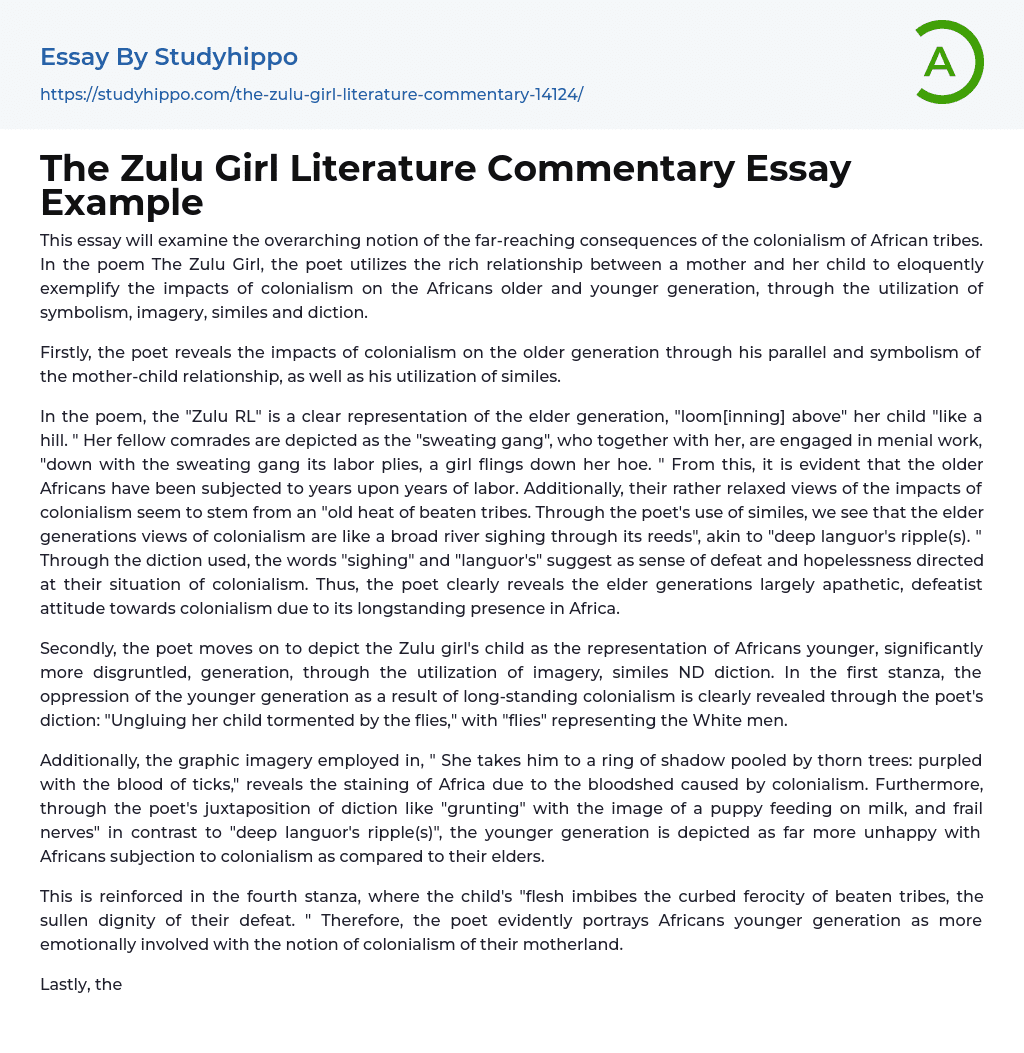This essay will examine the overarching notion of the far-reaching consequences of the colonialism of African tribes. In the poem The Zulu Girl, the poet utilizes the rich relationship between a mother and her child to eloquently exemplify the impacts of colonialism on the Africans older and younger generation, through the utilization of symbolism, imagery, similes and diction.
Firstly, the poet reveals the impacts of colonialism on the older generation through his parallel and symbolism of the mother-child relationship, as well as his utilization of similes.
In the poem, the "Zulu RL" is a clear representation of the elder generation, "loom[inning] above" her child "like a hill. " Her fellow comrades are depicted as the "sweating gang", who together with her, are engaged in menial work, "down with the sweating gang its labor plies,
...a girl flings down her hoe. " From this, it is evident that the older Africans have been subjected to years upon years of labor. Additionally, their rather relaxed views of the impacts of colonialism seem to stem from an "old heat of beaten tribes. Through the poet's use of similes, we see that the elder generations views of colonialism are like a broad river sighing through its reeds", akin to "deep languor's ripple(s). " Through the diction used, the words "sighing" and "languor's" suggest as sense of defeat and hopelessness directed at their situation of colonialism. Thus, the poet clearly reveals the elder generations largely apathetic, defeatist attitude towards colonialism due to its longstanding presence in Africa.
Secondly, the poet moves on to depict the Zulu girl's child as the representation of Africans younger, significantly more disgruntled, generation, through
the utilization of imagery, similes ND diction. In the first stanza, the oppression of the younger generation as a result of long-standing colonialism is clearly revealed through the poet's diction: "Ungluing her child tormented by the flies," with "flies" representing the White men.
Additionally, the graphic imagery employed in, " She takes him to a ring of shadow pooled by thorn trees: purpled with the blood of ticks," reveals the staining of Africa due to the bloodshed caused by colonialism. Furthermore, through the poet's juxtaposition of diction like "grunting" with the image of a puppy feeding on milk, and frail nerves" in contrast to "deep languor's ripple(s)", the younger generation is depicted as far more unhappy with Africans subjection to colonialism as compared to their elders.
This is reinforced in the fourth stanza, where the child's "flesh imbibes the curbed ferocity of beaten tribes, the sullen dignity of their defeat. " Therefore, the poet evidently portrays Africans younger generation as more emotionally involved with the notion of colonialism of their motherland.
Lastly, the poet subtly manipulates our perception of these two seemingly differing views on colonialism longing to the different generations of Africans, though his use of imagery and diction. From the poem, the poet hints at an existing undercurrent of unhappiness with colonialism amongst the elder generation.
Through the poet's continued use of kinesthesia imagery, " While her sharp nails, in slow caresses ruled, prowl through his hair with sharp electric clicks," we see that the seemingly deep divide in the elder and younger generations views of colonialism are bridged and rendered superficial, revealing the collective, shared sense of anger of the African people.
Additionally, this found unification in views of colonialism is enhanced in stanza four, "An old unquenched insurmountable heat, the curbed ferocity of beaten tribes. The words "unquenched", "insurmountable" and "curbed" all point to a sense of incompleteness and continuation of ancient sentiments, revealing the prevailing unhappiness of the elder generation. This is thus in line with the younger generations existing discontentment. Therefore, the poet subtly reveals the shared sentiments of the collective African people through imagery and diction.
In conclusion, we see that the poem can be viewed as an expose of the efferent views held by the two generations of African people on the sensitive topic of colonialism.
However, it is interesting to note that the poem has also succeeded, to a large extent, in bridging the gap between these two groups of Africans, ironically uniting them through the very topic of colonialism. 12/20 You need to first establish the literal meaning before Jumping into figurative. That way the organization of the argument will make sense. Do not from the start begin from the figurative reading because it is very confusing when there is enough explanation showing how you reach your conclusions.
- Christopher Columbus essays
- Pilgrims essays
- Simon Bolivar essays
- Exploration essays
- Book Summary essays
- Metaphor essays
- Reader essays
- Rhyme essays
- Literary devices essays
- Villain essays
- Books essays
- Genre essays
- Literary Criticism essays
- Writer essays
- Protagonist essays
- Simile essays
- Poem essays
- Book Report essays
- Book Review essays
- Greek Mythology essays
- Plot essays
- Tragic Hero essays
- Coming of Age essays
- Play essays
- Rhetoric essays
- Rhetorical Question essays
- Translation essays
- Understanding essays
- Reason essays
- Character essays
- Letter essays
- American Literature essays
- Literature Review essays
- Utopia essays
- Poetry Analysis essays
- Dante's Inferno essays
- Between The World and Me essays
- Incidents in The Life of a Slave Girl essays
- Flowers for Algernon essays
- Myth essays
- Everyday Use essays
- Boo Radley essays
- Genesis essays
- Richard iii essays
- Alice in Wonderland essays
- On the road essays
- Ozymandias essays
- The Nightingale essays
- Holden Caulfield essays
- Animal Farm essays




